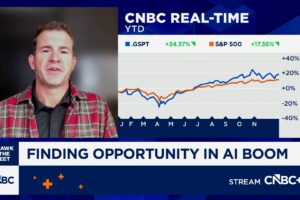We recently looked at Goldman Sachs’ Stocks With Highest Consensus Returns: 42 Stocks With The Highest Consensus ROE. In this piece, we will look at where Advanced Micro Devices, Inc. (NASDAQ:AMD) ranks in the list.
As the fourth quarter of 2024 settles in, the narrative surrounding stocks on Wall Street is starting to shift. This is unsurprising since the beginning of the Federal Reserve’s interest rate cycles stands to change economic conditions in America. These will naturally affect businesses, and cyclical stocks along with financials should see an improved outlook.
For instance, consider two reports by investment bank Morgan Stanley. One of these was released before the interest rate cut, and it covered the bank’s thoughts about the stock market and the US economy for September. The other came in October, after the rate cut. In its September report, MS laid out three scenarios for the flagship S&P index’s performance for the rest of this year. The best case scenario posits that the index would close at 5,650 points in the near term, while the “attractive” and “fair” scenarios predict a closing of 5,200 and 5,350 points, respectively. Yet, the market has outperformed even the best scenario, as its recent reading is 5,764.
The bank also shares that inflation is finally dropping in America. This fact is explained through the S&P’s second quarter earnings performance. In fact, the shifting inflationary trends have set new highs for a decade when we consider sales and earnings surprises for the index according to MS. Its data shows that when inflation was soaring in Q4 2022, the net of positive and negative EPS surprises stood in lowest quintile since businesses struggled with costs. This was despite the fact that during the same time period the net of positive and negative revenue surprises was in the 70% percentile. However, now that inflation has dropped, data for the second quarter earnings season shows that the EPS surprise was in the uppermost quintile (above 80%) while the revenue surprise had dropped to roughly 35%. This data covers the past ten years, and as a result, it illustrates the momentous shifts that the market is undergoing right now.
Since interest rates are the hottest topic on Wall Street, MS also commented on its expectations for them. At the September start, the bank posited that markets were expecting 100 basis points of cuts by 2024 end. The bank shared that it thought “this looks aggressive unless the U.S. economy has a hard landing, but this is not our base case.” With September’s 50 basis points cut out of the way, these expectations have remained unchanged as the CME Fed Watch Tool shows that for the Fed’s November and December meetings, the market has set the probabilities for a 25 basis point cut in each at 85.5% and 82.1%, respectively. These cuts are important for determining the market’s direction, as MS’ data shows that when economic activity as measured by the ISM Manufacturing Index sat at ~67 in 2010, the S&P’s 12 month total return was 30%.
Shifting gears to the October report, MS cautions that while historically equities have outperformed following the first Fed rate cut, elevated valuations, and “consensus forecasting of EPS acceleration rather than decline, equities upside after the first cut may prove more limited this cycle.” The bank’s key stock market insight from its October report comes through its comments about cyclical stocks, though. MS shares that as upward economic growth surprises softened from April through August, “sector and factor trends skewed defensive, consistent with softer economic growth.” However, this might not be the case moving forward, as shown by the Citi Global Economic Surprise Index. MS outlines that this index had bottomed out in August with a ~-25 reading, which had jumped to roughly -12 in September. This trend was mirrored in the difference between global cyclical and defensive sectors, with the reading also moving upward as the economic surprises jumped.
These factors are key when we analyze Goldman Sachs’ list of stocks with the highest expected ROE since the bank believes that stock quality will be determined by economic growth and economic rates. The bank also recently upped its 2024 closing target for the S&P to 6,000 points. This was the fourth revision of its target and a sizeable increase from the previous estimate of 5,600 points. This increase was also accompanied by optimism for the index’s earnings. GS now believes that S&P’s 2025 earnings will sit at $268, for a 4.7% revision from the previous estimate of $256. Its 2024 estimate is unchanged, though, and its value of $241 implies that earnings next year will grow by 11.2%.
As for the next 12 months, GS believes that the S&P will sit at 6,300 points, for an 8.9% growth over its recent value of 5,779. As MS’ data pointed out that EPS surprises are growing as inflation tames, Goldman is also of a similar view. This is because the bank’s chief US equity strategist David Kostin shares that the upward EPS revision is reflective of the fact that the “macro backdrop remains conducive to modest margin expansion, with prices charged outpacing input cost growth.” In a later note, the analyst outlined that “Over the past year, performance of several quality factors has tracked the broad trajectory of market views on growth and monetary policy.” Kostin added that “A positive jobs print could prompt some investors to rotate out of expensive ‘quality’ stocks into less-loved lower quality firms as the market would likely price lower odds of substantial labor market weakening.”
Our Methodology
To make our list of Goldman Sachs’ stocks with the highest consensus ROE, we used the bank’s latest list of 50 such stocks and chose those with a 5% or higher consensus ROE.
For these stocks, we also mentioned the number of hedge fund investors. Why are we interested in the stocks that hedge funds pile into? The reason is simple: our research has shown that we can outperform the market by imitating the top stock picks of the best hedge funds. Our quarterly newsletter’s strategy selects 14 small-cap and large-cap stocks every quarter and has returned 275% since May 2014, beating its benchmark by 150 percentage points. (see more details here).

A senior manager studying a market index alongside a team of young stock market analysts.
Advanced Micro Devices, Inc. (NASDAQ:AMD)
Consensus ROE: 42%
Number of Hedge Fund Investors in Q2 2024: 108
Advanced Micro Devices, Inc. (NASDAQ:AMD) is a semiconductor designer. The firm sells x86 based CPUs, GPUs, and custom chips. It has one of the most unique positions for any company in the world. In the CPU market, Advanced Micro Devices, Inc. (NASDAQ:AMD) competes with the larger rival Intel, while in the GPU market, it competes with Wall Street’s AI darling NVIDIA. Consequently, it is the only company within the trio with an established position in both markets. Like NVIDIA, Advanced Micro Devices, Inc. (NASDAQ:AMD)’s narrative in 2024 has focused on AI. Its ability to perform well depends on how well it can capture the AI accelerator market from NVIDIA and whether the AI products lead to bottom line profits. Additionally, Advanced Micro Devices, Inc. (NASDAQ:AMD) has also continued to gain CPU market share over Intel due to the latter’s struggles with manufacturing. With NVIDIA’s chips pricey and in short supply, the firm could see tailwinds from capturing sizeable AI accelerator orders from the likes of Tesla and Microsoft.
Advanced Micro Devices, Inc. (NASDAQ:AMD)’s data center division has been its fastest growing segment for several quarters. Here’s what management shared during the Q2 2024 investor call. Here is what they said:
“Turning to the segments, data center segment revenue increased 115% year-over-year to a record $2.8 billion, driven by the steep ramp of Instinct MI300 GPU shipments and a strong double-digit percentage increase in EPYC CPU sales. Cloud adoption remains strong as hyperscalers deploy fourth-gen EPYC CPUs to power more of their internal workloads and public instances. We are seeing hyperscalers select EPYC processors to power a larger portion of their applications and workloads, displacing incumbent offerings across their infrastructure with AMD solutions that offer clear performance and efficiency advantages.
The number of AMD-powered cloud instances available from the largest providers has increased 34% from a year ago to more than 900. We are seeing strong pull for these instances with both enterprise and cloud-first businesses. As an example, Netflix and Uber both recently selected fourth-gen EPYC Public Cloud instances as one of the key solutions to power their mission critical customer facing workloads. In the enterprise, sales were increased by a strong double-digit percentage sequentially. We closed multiple large wins in the quarter with financial services, technology, health care, retail, manufacturing, and transportation customers, including Adobe, Boeing, Industrial Light & Magic, Optiver, and Siemens. Importantly, more than one-third of our enterprise server wins in the first half of the year were with businesses deploying EPYC in their data centers for the first time, highlighting our success attracting new customers, while also continuing to expand our footprint with existing customers.”
Overall AMD ranks 7th on our list of stocks with the highest consensus ROE according to Goldman Sachs. While we acknowledge the potential of AMD as an investment, our conviction lies in the belief that some AI stocks hold greater promise for delivering higher returns and doing so within a shorter timeframe. If you are looking for an AI stock that is more promising than AMD but that trades at less than 5 times its earnings, check out our report about the cheapest AI stock.
READ NEXT: $30 Trillion Opportunity: 15 Best Humanoid Robot Stocks to Buy According to Morgan Stanley and Jim Cramer Says NVIDIA ‘Has Become A Wasteland’.
Disclosure: None. This article was originally published on Insider Monkey.






